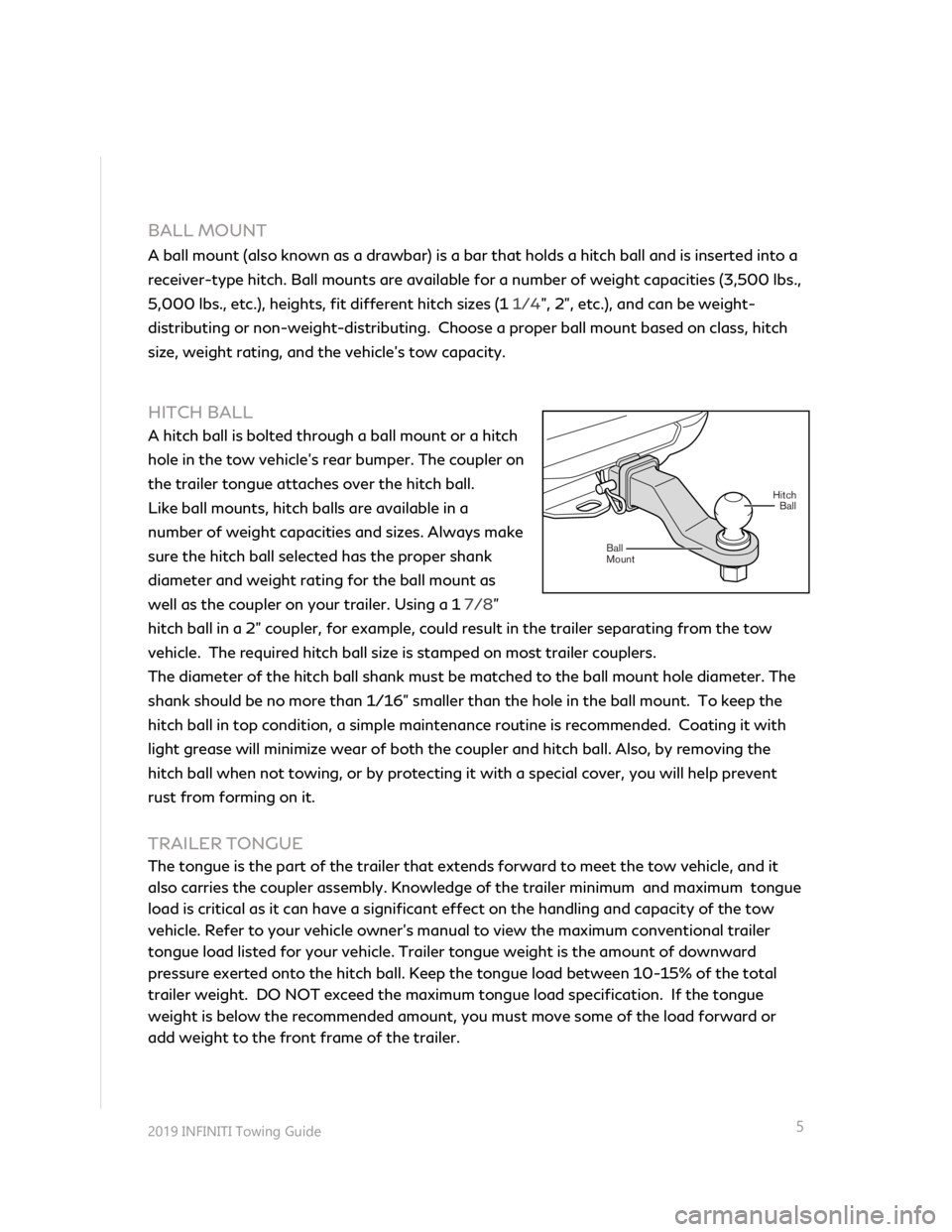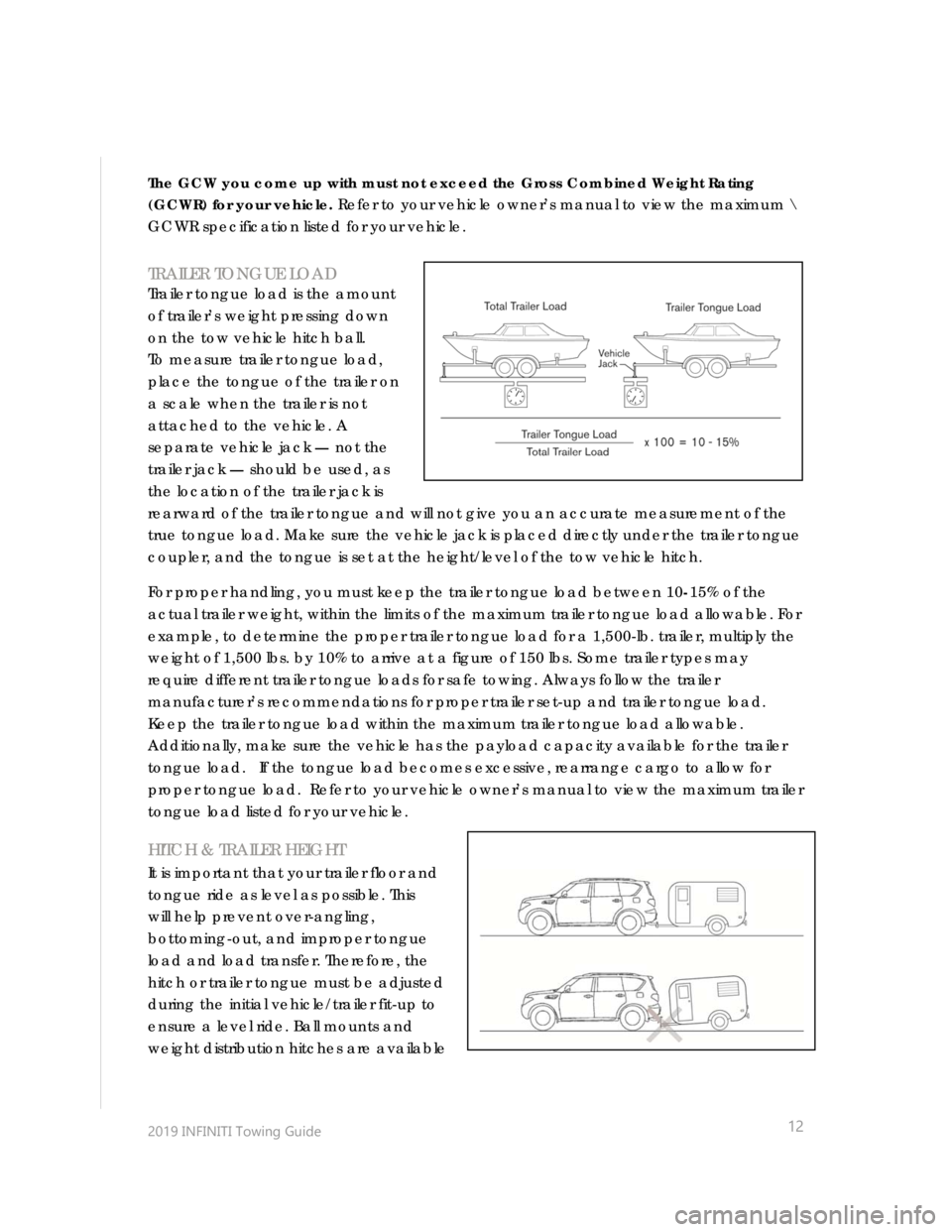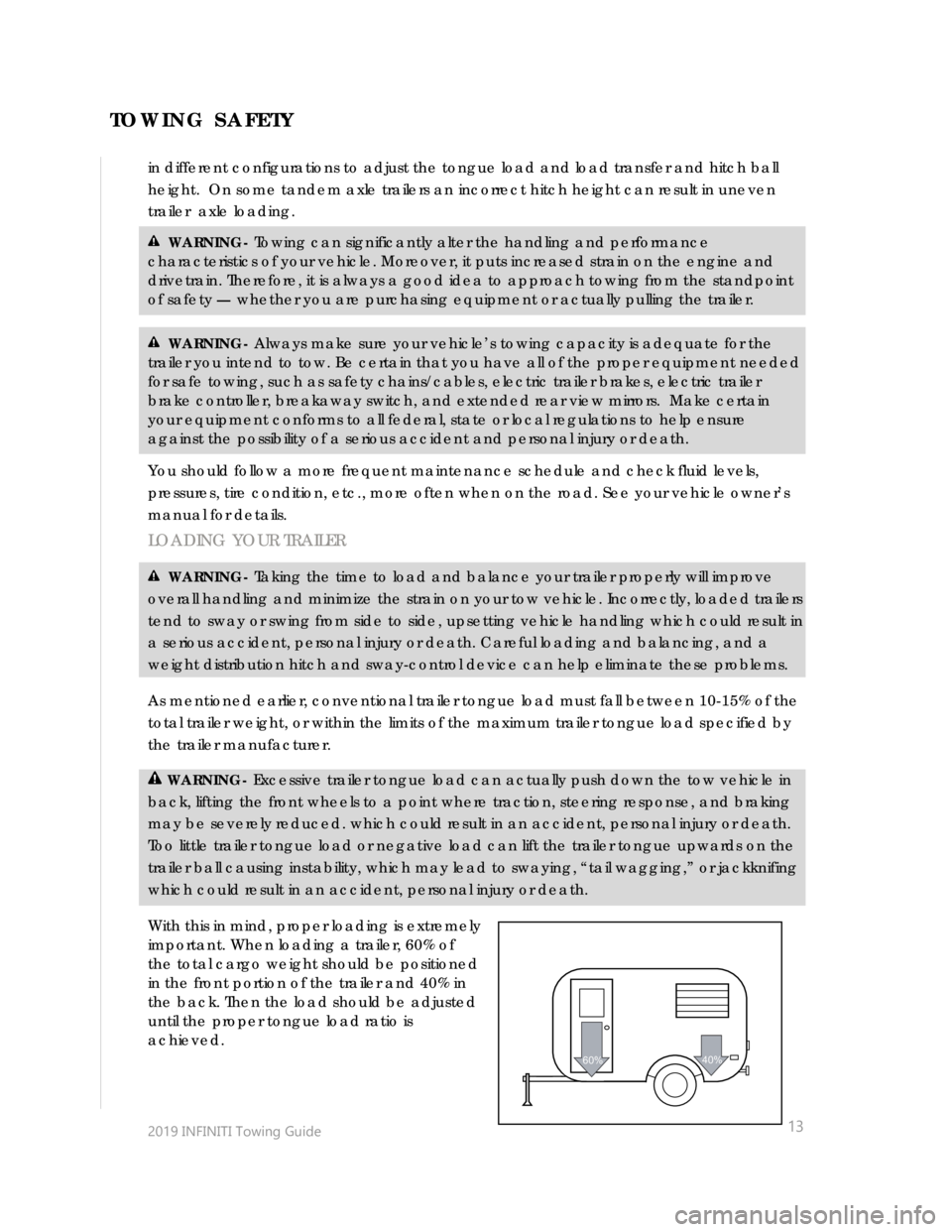height INFINITI QX30 2019 Towing Guide
[x] Cancel search | Manufacturer: INFINITI, Model Year: 2019, Model line: QX30, Model: INFINITI QX30 2019Pages: 25, PDF Size: 0.38 MB
Page 6 of 25

2019 INFINITI Towing Guide
5
BALL MOUNT
A ball mount (also known as a drawbar) is a bar that holds a hitch ball and is inserted into a
receiver-type hitch. Ball mounts are available for a number of weight capacities (3,500 lbs.,
5,000 lbs., etc.), heights, fit different hitch sizes (1 1/4”, 2”, etc.), and can be weight-
distributing or non-weight-distributing. Choose a proper ball mount based on class, hitch
size, weight rating, and the vehicle’s tow capacity.
HITCH BALL
A hitch ball is bolted through a ball mount or a hitch
hole in the tow vehicle’s rear bumper. The coupler on
the trailer tongue attaches over the hitch ball.
Like ball mounts, hitch balls are available in a
number of weight capacities and sizes. Always make
sure the hitch ball selected has the proper shank
diameter and weight rating for the ball mount as
well as the coupler on your trailer. Using a 1 7/8”
hitch ball in a 2” coupler, for example, could result in the trailer separating from the tow
vehicle. The required hitch ball size is stamped on most trailer couplers.
The diameter of the hitch ball shank must be matched to the ball mount hole diameter. The
shank should be no more than 1/16” smaller than the hole in the ball mount. To keep the
hitch ball in top condition, a simple maintenance routine is recommended. Coating it with
light grease will minimize wear of both the coupler and hitch ball. Also, by removing the
hitch ball when not towing, or by protecting it with a special cover, you will help prevent
rust from forming on it.
TRAILER TONGUE
The tongue is the part of the trailer that extends forward to meet the tow vehicle, and it
also carries the coupler assembly. Knowledge of the trailer minimum and maximum tongue
load is critical as it can have a significant effect on the handling and capacity of the tow
vehicle. Refer to your vehicle owner’s manual to view the maximum conventional trailer
tongue load listed for your vehicle. Trailer tongue weight is the amount of downward
pressure exerted onto the hitch ball. Keep the tongue load between 10-15% of the total
trailer weight. DO NOT exceed the maximum tongue load specification. If the tongue
weight is below the recommended amount, you must move some of the load forward or
add weight to the front frame of the trailer.
Hitch
Mount BallBall
Page 13 of 25

2019 INFINITI Towing Guide
12
The GCW you come up with must not exceed the Gross Combined Weight Rating
(GCWR) for your vehicle. Refer to your vehicle owner’s manual to view the maximum
GCWR specification listed for your vehicle.
TRAILER TONGUE LOAD
Trailer tongue load is the amount
of trailer’s weight pressing down
on the tow vehicle hitch ball.
To measure trailer tongue load,
place the tongue of the trailer on
a scale when the trailer is not
attached to the vehicle. A
separate vehicle jack — not the
trailer jack — should be used, as
the location of the trailer jack is
rearward of the trailer tongue and will not give you an accurate measurement of the
true tongue load. Make sure the vehicle jack is placed directly under the trailer tongue
coupler, and the tongue is set at the height/level of the tow vehicle hitch.
For proper handling, you must keep the trailer tongue load between 10-15% of the
actual trailer weight, within the limits of the maximum trailer tongue load allowable. For
example, to determine the proper trailer tongue load for a 1,500-lb. trailer, multiply the
weight of 1,500 lbs. by 10% to arrive at a figure of 150 lbs. Some trailer types may
require different trailer tongue loads for safe towing. Always follow the trailer
manufacturer’s recommendations for proper trailer set-up and trailer tongue load.
Keep the trailer tongue load within the maximum trailer tongue load allowable.
Additionally, make sure the vehicle has the payload capacity available for the trailer
tongue load. If the tongue load becomes excessive, rearrange cargo to allow for
proper tongue load. Refer to your vehicle owner’s manual to view the maximum trailer
tongue load listed for your vehicle.
HITCH & TRAILER HEIGHT
It is important that your trailer floor and
tongue ride as level as possible. This
will help prevent over-angling,
bottoming-out, and improper tongue
load and load transfer. Therefore, the
hitch or trailer tongue must be adjusted
during the initial vehicle/trailer fit-up to
ensure a level ride. Ball mounts and
weight distribution hitches are available
Page 14 of 25

2019 INFINITI Towing Guide
13
in different configurations to adjust the tongue load and load transfer and hitch ball
height. On some tandem axle trailers an incorrect hitch height can result in uneven
trailer axle loading.
WARNING- Towing can significantly alter the handling and performance
characteristics of your vehicle. Moreover, it puts increased strain on the engine and
drivetrain. Therefore, it is always a good idea to approach towing from the standpoint
of safety — whether you are purchasing equipment or actually pulling the trailer.
WARNING- Always make sure your vehicle’s towing capacity is adequate for the
trailer you intend to tow. Be certain that you have all of the proper equipment needed
for safe towing, such as safety chains/cables, electric trailer brakes, electric trailer
brake controller, breakaway switch, and extended rear view mirrors. Make certain
your equipment conforms to all federal, state or local regulations to help ensure
against the possibility of a serious accident and personal injury or death.
You should follow a more frequent maintenance schedule and check fluid levels,
pressures, tire condition, etc., more often when on the road. See your vehicle owner’s
manual for details.
LOADING YOUR TRAILER
WARNING- Taking the time to load and balance your trailer properly will improve
overall handling and minimize the strain on your tow vehicle. Incorrectly, loaded trailers
tend to sway or swing from side to side, upsetting vehicle handling which could result in
a serious accident, personal injury or death. Careful loading and balancing, and a
weight distribution hitch and sway-control device can help eliminate these problems.
As mentioned earlier, conventional trailer tongue load must fall between 10-15% of the
total trailer weight, or within the limits of the maximum trailer tongue load specified by
the trailer manufacturer.
WARNING- Excessive trailer tongue load can actually push down the tow vehicle in
back, lifting the front wheels to a point where traction, steering response, and braking
may be severely reduced. which could result in an accident, personal injury or death.
Too little trailer tongue load or negative load can lift the trailer tongue upwards on the
trailer ball causing instability, which may lead to swaying, “tail wagging,” or jackknifing
which could result in an accident, personal injury or death.
With this in mind, proper loading is extremely
important. When loading a trailer, 60% of
the total cargo weight should be positioned
in the front portion of the trailer and 40% in
the back. Then the load should be adjusted
until the proper tongue load ratio is
achieved.
60%40%
TOWING SAFETY